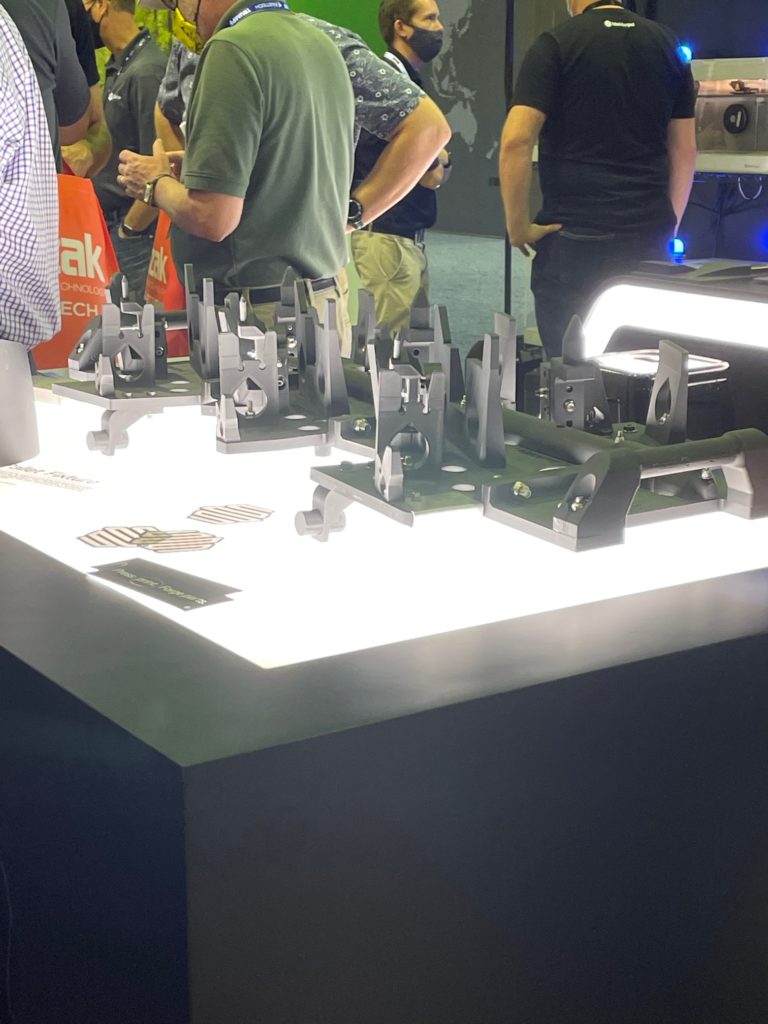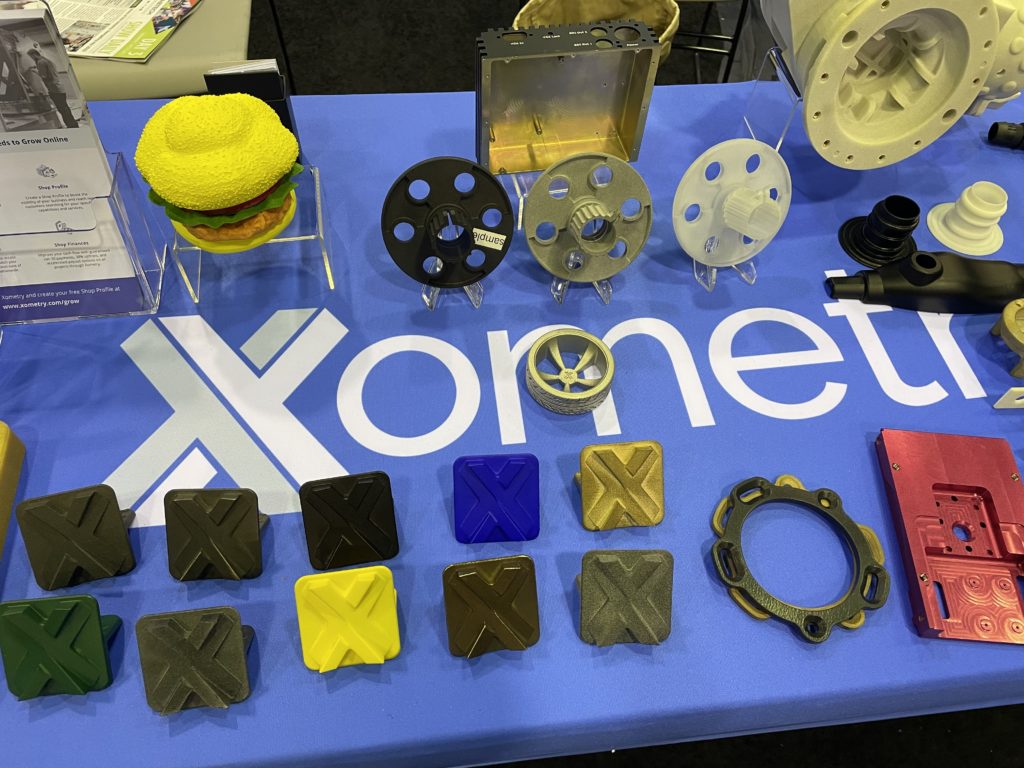In a recent series of Formnext articles, I wrote that there were a number of practical tips and observations concerning trade show stands which people were very positive about. Because some readers wanted more tips I’ve rounded up the best suggestions, ideas, and best practices for a (3D printing-specific) trade show stand.
I’ve worked on marketing teams organizing for events multiple times for large and small companies. I’ve done the no-budget, just smiles booth and the catered-everything approach, as well as pushed flight cases and fiddled with duck tape. I’ve also evaluated, compared and visited an awful lot of stands. I pay a lot of attention to these booths because I think that it is the purest expression of a company’s soul. In a very concentrated time and space, you get to see what they want most of all to be and become. Are they clean, aspirational, cool? Are they looking for money, partners, sales, to sustain a dream? It’s all there plain as day.
So, I’ve spent an awful lot of time on stands and more time than most looking at them anthropologically. I’ve manned booths for countless hours and done some organizing. I’m not a stand designer-and-builder or a PR events manager, however. So, see this as the observations of a studious layman rather than an expert.

Markforged booth at the RAPID + TCT 2021 in Chicago. Image courtesy of Sarah Saunders/3DPrint.com
Data Capture
Most of the time, pass-scanning equipment doesn’t work well. Come up with alternatives. One iPad with a simple form is often very valuable as a back up or a primary way to capture data.
At booths or on name cards, there should be an option somewhere to immediately plan a sales call with the person that you are talking to. There are smart or QR-based cards that allow you to connect with someone or exchange iCal info. These could be handy at stands, as well.
Post-Show Emails
Post-show emails are always generic and not engaging. I think a lot more value can be extracted by making these personal—e.g., just looking at someone’s LinkedIn profile briefly and giving them the appropriate information. A lot of post-show emails don’t introduce the company or rehash what they do. It’s important to do this because, often, I have no idea who you were, as I met so many people. A simple link to a video showing the stand team saying “hi” or waving may trigger my memory.
Additionally, very few to no post-show emails give you actionable options within the message. It would be nice to have a link to “book a conversation with a sales engineer”, “receive a materials sample pack”, “view a webinar”—a menu of ways to let me easily interact with your brand. Often, I just want to know that your company exists. “Oh cool PP filament. That may be something I’ll use.” An option to follow you on LinkedIn or connect with you or to receive a meeting or email in six months may be helpful.
A lot of booth teams take your email and then subscribe you to a newsletter. This is not allowed in the E.U. and is bad form anywhere.
Alternative Engagement
I’m surprised that people don’t let you sign up to receive a sample pack of materials and information in the mail. This is a great pretext for a follow-up call and a very engaging way to get to know people.
I’m also taken aback that not more firms encourage you to fill out a short survey and then obtain your STL printed with a follow up call. If I’m really evaluating materials, then this would be very helpful.
You’d also think that there would be more vertical-specific webinars pursuant to a trade show. This would be a very low-effort way to segment and create laid-back engagement with potential customers.

PR
In the case of a big trade show, the journalists are going to be spending a great deal of time meeting people and conducting interviews. So, the right time to release news is three weeks in advance. Work with the journalists to prepare the story ahead of the event and then release it during the show.
A lot of firms seem very focused on putting out press releases during an event. Why not do it just before so that attendees can plan to visit you? To me, this is more effective in driving traffic to your stand and creating buzz. I’m much more likely to plan to visit someone than to learn about someone amid the event itself.
Many businesses release news can be quite dull during a trade show because they feel they have to announce something. Lately companies have taken to providing emails labelled something along the lines of “LAST MINUTE CORRECTION”, in which they resend a press release with a slight correction. I believe that this is in the hope that someone will see it now. All of this can give off a whiff of desperation and may not be the best look.
Many PR people are absolutely duplicitous but somehow think that journalists won’t notice this and gossip about bad actors. Some firms publish outright lies and exaggerations in press releases. In some cases, the public and potential customers are convinced by these misrepresentations. However, there are a lot of individuals in our industry that tend to be a tad critical when buying a $300K machine tool. So, in this case, the lies may get published but will actually erode your brand over time.
Many PR people will email once to ask if I will accept an embargoed news item, once more thanking me for promising not to publish news ahead of the embargo date, another time with a tidbit of information, then once more with the press release, and, finally, once again with photos. This is time-consuming and inconsiderate.
People are still not making enough photos available to the press and public or are not making the right photo formats available to blogs. TIFF? Really?
Subscribe to Our Email Newsletter
Stay up-to-date on all the latest news from the 3D printing industry and receive information and offers from third party vendors.
You May Also Like
IperionX Inks 10-Year Deal with Wisconsin Manufacturer for 80 Metric Tons of Titanium Per Year
IperionX, the Charlotte-based supplier of sustainable titanium powders used for additive manufacturing (AM) and metal injection molding (MIM), has signed a ten-year deal with United Stars, a group of industrial...
Gastronology Launches Industrial Production of 3D Printed Food for Dysphagia Patients
Food 3D printing has, in many ways, been an additive manufacturing (AM) segment looking for the right business case. While some applications are beautiful and others may or may not...
Lockheed Martin Leads $3M Investment in Q5D’s Electronics 3D Printing System
Q5D, an original equipment manufacturer (OEM) of robotic arm, hybrid additive manufacturing (AM) systems used for wire harness production, has closed a $3 million investment round. The investment arm of...
3D Printing News Briefs, April 6, 2024: Depowdering, Cybertruck Door Handles, & More
In today’s 3D Printing News Briefs, ioTech’s digital manufacturing CLAD technology is opening up opportunities for microelectronics and additive manufacturing. Hexagon and Raytheon Technologies commercially released the Simufact Additive Process...































